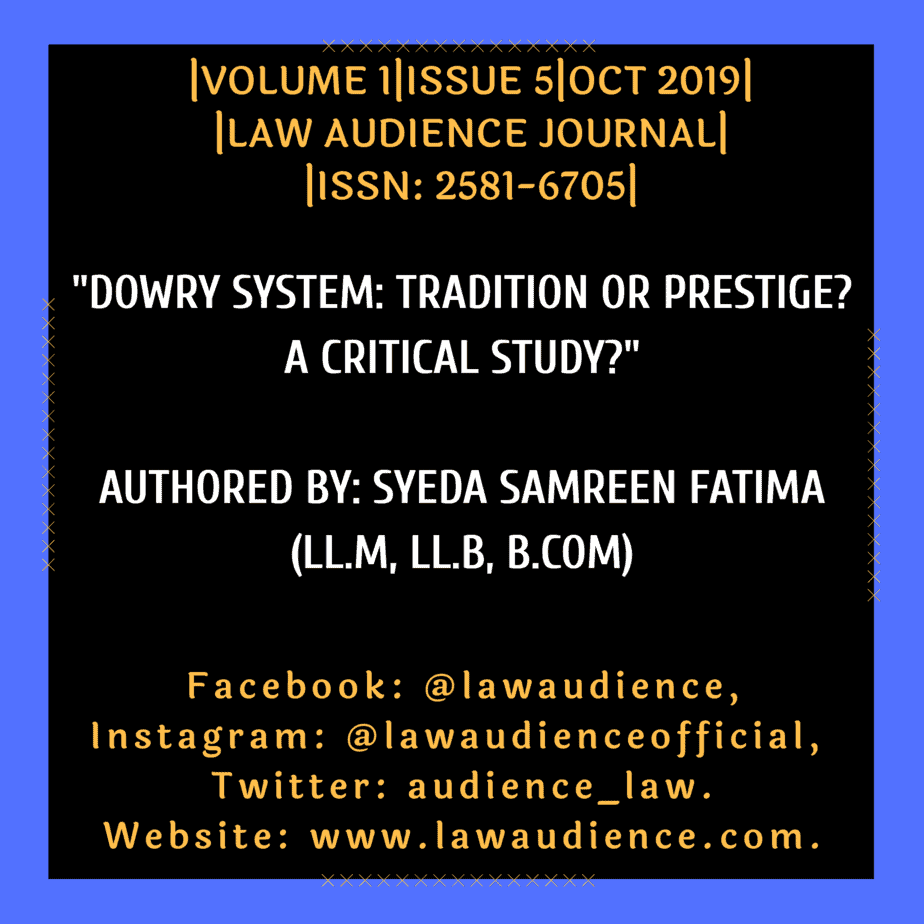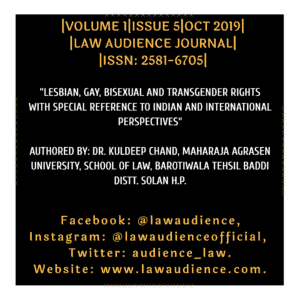Authored By: Syeda Samreen Fatima (LL.M, LL.B, B.COM),
I. ABSTRACT:
The word “Dowry” denotes any property, moveable or immovable given or agreed to be given at the time of marriage either directly or indirectly generally under coercion or pressure. Giving dowry during the marriage as part of the bride’s price or inheritance share has been a common practice during ancient Vedic time. However, this tradition lately has morphed into a prestige issue for parents of both the bride and the groom. This study explores the practice of giving dowry, not primarily a means of transferring property at the time of marriage, but significantly a mode of representing social status and prestige in the community. Despite the provisions enacted under the “Dowry Prohibition Act, 1961”, making dowry, a non-compoundable and non-bailable offence under section 8(2), taking and giving of dowry is still prevalent in India and the newlywed bride is subjected to violence for not bringing in enough dowry. As a means of deterrence, the Indian Penal Code has incorporated Section 304-B (dowry deaths) and 498-A, dowry related violence by the husband and in-laws of the bride and penalty therewith. The paper further explores society’s discursive construction of dowry marriage and people’s understanding of it to reflect on their social relations.
II. INTRODUCTION:
The word “Dowry” or “Dahez” or “Varakatnam” in a sense of an expression is demand for valuables from the bride’s parents, agreement to the wedding. Initially, money during the time of the marriage was given to the bride to secure her future as “streedhan” which literally means women’s property and not for the groom or to his family to utilize. The question lies as to how far the extent of taking or giving of the dowry has spread. Irrespective of the religion or caste it is spread all over the Indian sub-continent neighbouring countries of Pakistan, Nepal and Bangladesh. To some it’s the tradition acceptable by their forefathers, so they too find a need to follow it. And some are making it a prestige issue as to the quantum of the dowry given in marriage to their daughters should be more than others, belonging to the same community or caste. For many, being part of the society and coming from poor families, marrying their daughters is nothing less than a hurdle to cross. But greed for money, brides are tortured by their in-laws and husbands to give away all the valuables brought by them or to get more from their parental home. The contemporary dowry no longer resembles the old traditional version but instead has evolved as material acquisition and became increasingly important to all levels of the society. Now, even for the poorest of the family’s dowry includes valuables, like electronics, furniture etc. This system is so deep-rooted in the Indian society it’s far from reaching the goal of dowry free marriages, making the brides suffer in their in-law’s home if they can’t meet the requirements of the groom’s family.
III. ORIGIN OF THE WORD DOWRY:
Dowry is cash, durable goods and moveable property given by the bride parents to the groom or his relatives or parents as a condition to the marriage. Such transfers are generally under coercion or duress[1]. The practice of taking and giving Dowry was first originated in the late Vedic period between 2500 B.C. to 1500 B.C.[2] Historical eyewitness reports, in Ancient India dowry was insignificant, and daughters had inheritance rights, which by custom exercised at the time of their marriage. And the documentary evidences suggest that beginning of the 20th-century bride price, rather than dowry was the common custom. ‘Bride’s Price’ is either cash, valuables or possessions given to the bride by the bride’s parents during the marriage. The bride’s price, will in, turn become the property of the groom or his relatives upon marrying the girl. This practice of giving valuables in medieval times to get a good match for brides was nothing but trade (insulting practice).
It was claimed that the ancient code of Manu sanctioned dowry and bridewealth in ancient India, but dowry was the most prestigious form and associated with upper-caste (Priestly caste) and was restricted in the lower caste.[3] On the other hand, Islam has strictly objected to this kind of practice before and today too by making husband responsible to pay a dowry (dower) to the bride during the marriage.
Prophet Mohammed, The Messenger of Allah, peace be upon him, stated, “The most blessed marriage is one in which the marrying partners place the least burden on each other”. The first era of Islam witnessed marriage as a simple affair. Any expenditure incurred in its performance was minimal, and not burdensome on either family.
Michael Weitzel, in contrast, observed ancient Indian literature suggest dowry practice was not significant as the bride was having inheritance rights either by appointment or when they do not have brothers.[4] According to McDonell and Keith during 200-700 B.C. property rights for women increased in India.[5] James Lochtefeld suggests that bridal adornment with jewellery, ceremonial dress along with the gifts that were her property, not demanded by the groom in marriage was listed by Manu and others.[6] India has seen the inheritance share of daughters from their father’s property equal to the fourth part of their brothers.[7] Until then it was unclear as to daughter’s inheritance laws in India after Al-Biruni’s visit in 11th Century. There were no proper inheritance laws prior to British Raj till 1956. And, it was unclear as to how quickly the practice of dowry demand by grooms began, whether this happened after Manu sanctioned dowry or it’s the inheritance laws after 11th Century.
IV. LEGISLATIVE PROVISIONS IN RELATION TO DOWRY:
In concern with a number of dowry-related issues and offences Government of India introduced many legislative provisions. The first all India legislative enactment relating to dowry was introduced on 1st of July 1961,[8] repealing the local laws such as Andhra Pradesh Dowry Prohibition Act, 1958 and The Bihar Dowry Restraint Act, 1950.
V. DOWRY PROHIBITION ACT, 1961:
The provisions under section 3 of the Dowry Prohibition Act, 1961 provides for the penalty on persons who gives takes or abets giving or receiving dowry. In relation to the clarification of “streedhan” and dowry, it was held that any valuables given to the bridal couple in connection with marriage constitutes dowry and any property given to or meant for the bride constitute “streedhan”.[9] The punishment could be 5 years imprisonment and a fine of Rs.15000 or the value of the dowry received, whichever is more.[10]
In Indravati v. Union of India[11], section 3 of the Act was challenged arbitrary and in contravention of the articles 14, 19, 21 and 22 of the Indian Constitution and hence ultra vires. Court held section 3 of the Dowry Prohibition Act, 1961 does not contravene the above-mentioned articles of the Indian Constitution, and hence not ultra vires of the said articles.
Penalty for giving and taking dowry is not applicable in case of the presents given at the time of marriage without any demand.[12]
According to section 4 of the Act any person who demands dowry directly or indirectly from the parents or relatives of the either spouses as the case may be, shall be punishable with a term not less than 6 months which may extend to two years and with a fine which may extend to ten thousand rupees.
The offence of demanding dowry holds good even before marriage is solemnised and constant demand of dowry after marriage attracts section 4 of the Dowry Prohibition Act, 1961.[13] Bar on limitation of filing a complaint under the Dowry Prohibition Act, 1961 was removed. Now a woman can file a complaint against the persons harassing her for the dowry, may it be six years or more.
VI. CRIMINAL LAWS AGAINST DOWRY:
In view of the increasing number of dowry-related offences against women, Government of India introduced many legislative provisions under Indian Penal Code, 1860 and Criminal Procedure Code, 1973 and Indian Evidence Act, 1872. Section 304(B) Indian Penal Code deals with dowry death. Death of a woman under suspicious circumstances within seven years of her marriage or any bodily injury or burns caused to her and if shows clearly as to she was subjected to cruelty or torture soon before her death by her husband or in-laws shall be deemed to have caused her death. Offences under this section are cognizable, non-compoundable and are non-bailable. Penalty for causing dowry death under section 304 (B) is imprisonment for seven years which may extend to life imprisonment. In most of the dowry death and related cases, the direct evidence is hard to procure and depends on circumstantial evidences. Section 304 (B) IPC and Section 113 B Indian Evidence Act both enact a rule of presumption (death of the woman occurs within seven years of marriage and under suspicious circumstances). If the prosecution fails to prove that death occurred within the period of seven years, then this section doesn’t apply.[14]
Section 498A Indian Penal Code, 1860 was specifically added later in the year 1983 to protect women against cruelty and harassment by her husband or her in-laws. Further, the section 498A widened the explanation of cruelty not limited to only physical cruelty but mental cruelty too. Whoever being husband or relative of woman subject her to cruelty or harassment shall be punishable with imprisonment for a term which may extend to three years and shall be liable to pay fine. The Constitutionality of section 498A was challenged before the Supreme Court on the ground of being abusive, and that it gives arbitrary power to police and the court.
In Sushil Kumar Sharma v. Union of India[15], the decision was upheld by the Supreme Court and further held that the courts can take cognizance of the offence only when it receives the report of the fact from police or upon a complaint made by the victim or her relatives, under Code of Criminal Procedure for the prosecution of offences under 498A IPC.
Section 113-A, Indian Evidence Act deals with presumption as to the abetment of suicide by a married woman. Presumption as to the suicide of woman had been abetted by her husband or relatives within a period of seven years of her marriage subject to the cruelty or harassment. Section 113-B, deals with presumption as to dowry death when it is shown that the woman is subjected to cruelty or harassment because of dowry demand. Code of Criminal Procedure 176(1) provides inquiry by a magistrate into the cause of death.
VII. CRITICISMS AGAINST EXISTING DOWRY LAWS:
Section 498A IPC was criticized on the grounds of non-bailable and cognizable offence and that it involves mechanical arrest by the police officials.[16] In Nisha Sharma and Munish Dayal Anti Dowry Lawsuit 2003, Nisha accused her husband of demanding dowry. The case ended in 2012 after the Court acquitted all the accused.[17] The Court observed that Nisha was in a relationship with another man whom she wanted to marry. Just like Nisha Sharma case there are many false dowry harassment cases where wives were threatening their husband or relatives for their own benefits.
Later Supreme Court in Preeti Gupta and Another v. State of Jharkhand Another[18], directed the authorities for detailed investigation to stop possible misuse of the anti-dowry laws. Based on the Supreme Court’s judgement in the above case, Parliament set up a committee headed by Bhagat Singh Koshayari.[19]
Further in Arnesh Kumar v. State of Bihar & Anr[20], a two-judge bench of Supreme Court reviewed enforcement of section 41 (1)(A) Cr.PC. which instructs the State to follow certain procedure before making an arrest and went on to observe that Section 498A has become a very powerful weapon in the hands of the disgruntle wives where innocent people are getting arrested without any evidence due to non-bailable, cognizable nature of the offence. In 2015, the Indian Government sought to introduce a bill to amend Section 498A IPC based on the suggestions of the Law Commission and Justice Malimath Committee on Law reforms of Criminal Justice.
VIII. INTERNATIONAL CONVENTIONS:
Gender inequality was seen much before the United Nations even established in the year 1945. United Nations Charter contains many provisions for the advancement of women as they prefer equality between both men and women. Irrespective of religion, race, caste, sex, colour and status etc., the Universal Declaration of Human Rights 1948, proclaims that it applies to all human beings. International Covenant on Social, Economic and Cultural Rights, 1966 and International Covenant on Civil and Political rights 1966, and various other regional and International Conventions on human rights of women become International concern when U.N. General Assembly adopted the Convention on Elimination of all Forms of Discrimination against women adopted in the year 1979 and became effective in the year 1981. India signed the Convention in 1980 and ratified it on July 9, 1993. This convention is specifically articulated its aim to modify the social and cultural patterns of the conduct of men and women with a view to achieving the elimination of the prejudices and customs and all other practices based on the idea of inferiority or superiority of the either sexes or stereotyped roles of men and women.[21]
On the other hand Article 16 of Universal Declaration of Human Rights, 1948 envisages “Men and women without any limitation due to race, nationality or religion, have the right to marry and form a family. And they are entitled to equal rights as to marriage, during marriage and its dissolution”. The Vienna Declaration and Programme of Action adopted by the World Conference on Human Rights, 1993 states “The human rights of women and girl child are inalienable, integral and indivisible part of the universal human rights”.
According to The Declaration on the Elimination of Violence Against Women adopted in the year of 1993 by United Nations defined violence against women as “any act of gender-based violence that results in, or is likely to result in, physical, sexual or psychological harm or suffering to women, including threats of such acts, coercion or arbitrary deprivation of liberty, whether occurring in public or in private life.” The definition is further as Violence against women shall be understood to encompass, but not limited to the following:
- Physical, sexual and psychological violence occurring in the family, including battering, sexual abuse of female children in the household, dowry-related violence, marital rape, female genital mutilation and other traditional practices harmful to women, non-spousal violence and violence related to exploitation.
- Physical, sexual and psychological violence occurring within the general community, including rape, sexual abuse, sexual harassment and intimidation at work, in educational institutions and elsewhere, trafficking in women and forced prostitution
- Physical, sexual and psychological violence perpetrated or condoned by the State, wherever it occurs.[22]
As a consequence of the resolution, the United Nations General Assembly in the year 1999 declared 25th November as “International Day for the Elimination of Violence against Women.”[23] Even Article 29 “Beijing Declaration and Platform for Action”, fourth world conference on women, envisage “Prevention and Elimination of all forms of violence against women and girls”.
The Declaration further calls on nations to enact and enforce legislation against perpetrators for the act of violence against women, mostly dowry-related violence. Hence India as a party to the “Beijing Declaration and Platform for Action” and various other covenants and declarations, must exercise with due diligence with regards to dowry deaths to ensure the realization of human rights.
IX. CONCLUSION:
The present article proposes that contemporary dowry no longer resembles the traditional out-dated version of transferring assets to the bride as ‘Streedhan’ or ‘Bride Price’, rather became a prestige issue. What was once a tradition became an expectation, later demand and then prestige. In India, nearly a quarter of the savings of an average middle-class family is spent on the marriage of their daughter on her dowry and other marriage arrangements. Even for the poorest families, a typical dowry now consists of lavish items such as automobiles, cash, electronic items etc. Dowry has evolved as a material acquisition and has become increasingly important at all levels of society. As a result of which it has become a part of every marriage in Indian society. In today’s scenario, dowry is fixed based on caste, creed, colour, education and earnings of grooms to be. Irrespective of various legislative provisions to prohibit dowry and International Conventions, dowry continues to be a part of Indian marriages because even the best of laws cannot play an important role in the eradication of the dowry, if the level of legal consciousness in society is negligible with regard to understanding of law and to relevant legal estimations and attitudes.[24]
India as a party to various International Conventions too failed to comply with the women’s right against violence. Since dowry is so deep-rooted in Indian society it can’t be uprooted easily. There should be combined efforts from both parties, society, Non-Government organisations, Judiciary and executive against taking dowry, dowry deaths and violence against women and moreover upholding the dignity and status of women equally as men in the society.
[1] Jethmalani and Dey.
[2] KAMLADEVI CHATOPADHYAY, Indian Women Battle for Freedom 21 (1983).
[3] Stanley; Goody, Jack (1973). Bride wealth and Dowry. Cambridge UK: Cambridge University Press. p. 71.
[4] Witzel, Michael. “Little Dowry, No Sati: The Lot of Women in the Vedic Period.” Journal of South Asia Women Studies 2, no. 4 (1996).
[5] McDonell, Arthur and Keith, Arthur. Vedic Index: Names and Subjects, Indian Text Series (John Murray, London, 1912), Volume 1:482-485.
[6] James G. Lochtefeld, The Illustrated Encyclopedia of Hinduism: A-M, Rosen Publishing, ISBN 9780823931798; 203.
[7] Edward Sachau (Translator), Biruni, Muhammad ibn Aḥmad, Alberuni’s India (Vol. 2), Kegan Paul, Trench, Trübner & Co. (London, 1910.) Chapter LXIX: 154.
[8] Dowry Prohibition Act, 1961.
[9] Hakam Singh vs State of Punjab (1990) I DMC 343.
[10] Sec 3(1) Dowry Prohibition Act, 1961.
[11] I (1991) DMC 117 All.
[12] Section 3(2) Dowry Prohibition Act, 1961.
[13] Harbhan Singh vs Smt.Gurucharan Kaur 1993 Rec Crr 404 (Del).
[14] Ratan Lal vs State of Madhya Pradesh 1994 Cri LJ 1684.
[15] AIR 2005 SC 3100.
[16] “Amend dowry law to stop its misuse, SC tells Govt”. The Times of India. 17 August 2010. Archived from the original on 7 July 2012.
[17] “All let off in Nisha Sharma dowry case after 9 years”. CNN-IBN. 1 March 2012. Archived from the original on 4 March 2015. Retrieved 28 March 2015.
[18] AIR 2010 SC 3363.
[19] Review of Dowry Act Archived from original 18th May 2015.
[20] AIR 2014 SC 2756.
[21] Convention on The Elimination of All Forms of Discrimination Against Women, 1979, Article 5.
[22] Declaration on the Elimination of Violence against Women – UN Documents: Gathering a body of global agreements”.
[23] Declaration on The Elimination of Violence Against Women, 1993, Article 1.
[24] Redelbach, supra note, 118, at 212.



